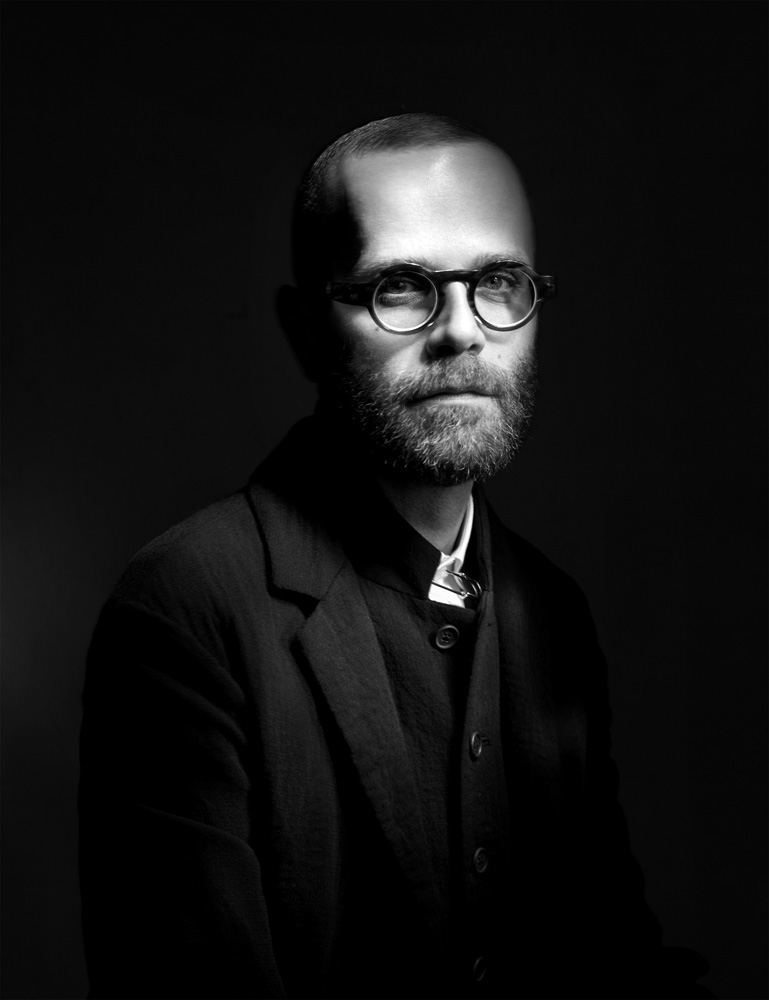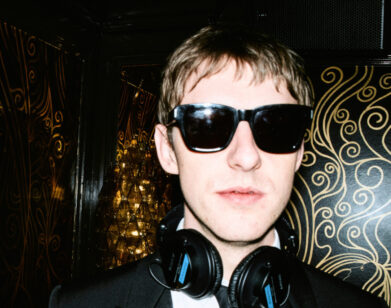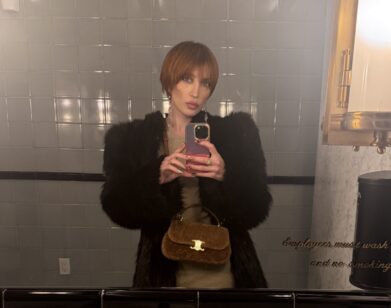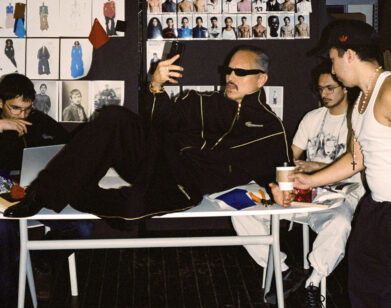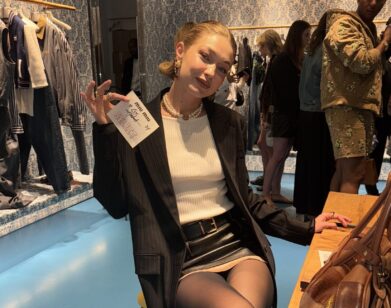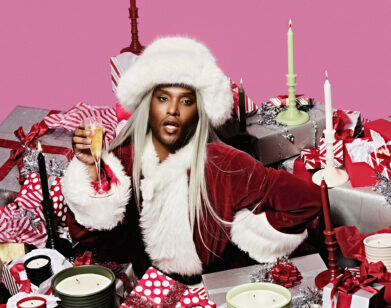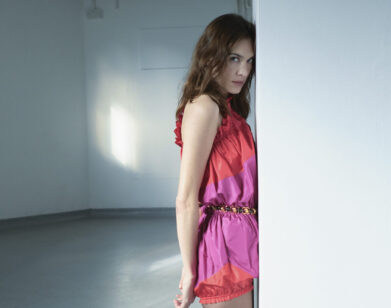Angelo Flaccavento
Even out on the fashion circuit, among the most garish show birds in all their vibrant plumage, the critic and curator Angelo Flaccavento cuts quite a figure. Not that he is terrifically flamboyant in his own attire. Compared with the other peacocks on their near-constant migration between London, Milan, Florence, Paris, and New York, Flaccavento, in his customary wide-legged trousers and bowtie, is relatively quiet and orderly in his presentation—all the better, as Flaubert might have it, to be wild and original in his work. And it is in his work—be it his witty and profoundly insightful runway reviews for the Business of Fashion or in exhibitions, like the intensely experiential one he recently devised for January’s Pitti Immagine Uomo in honor of Kiton’s founder, Ciro Paone—where Flaccavento shows his stripes and his utterly unique pedigree.
The self-described radical, 44, born and raised in an ancient hilltop city in southern Sicily, where he still lives part time, was, from the very beginning, he says, drawn to extremes—from the baroque architecture that populates his hometown of Ragusa to the high-conceptual brutalism of Rei Kawakubo, a shop window full of whose designs for Comme des Garçons first turned Flaccavento on to fashion when he was 11. And still these extremes—the thumbing backward into fashion’s history paired with a keen insight into the evanescent present—animate much of Flaccavento’s thought and work, and even provide inspiration for his Instagram handle: @poeticallypunk.
Last January, while he was still in Florence, fresh off his triumphant exhibition, and in between deadlines, Flaccavento took a moment to speak with another fashion iconoclast, Edward Buchanan, formerly the designer of Bottega Veneta, who had, the night before, presented the latest collection for his own line, Sansovino 6. During that all-too-rare moment of reflection amid the hustle of design and commerce, Buchanan was able to get his friend to go on the record about where he comes from and where he thinks it is all going.
EDWARD BUCHANAN: Angelo! Buongiorno.
ANGELO FLACCAVENTO: Buongiorno.
BUCHANAN: Did you have your coffee already?
FLACCAVENTO: I did. But I don’t know how this conversation can take place—because who is interviewing who?
BUCHANAN: I’m interviewing you! It’s a turning of tables. So we know so much about the exterior of Angelo Flaccavento, this international bad-ass, traveling from city to city, and what I find really intriguing is that you’re Sicilian—you live in Ragusa and Milan—and you always return to Ragusa. Tell me about those roots.
FLACCAVENTO: Ragusa is for me a little bit of a fort. Everybody who comes from an island wants to go into the world and explore, but we always come back. But as soon as I come back, I always know that I will leave again pretty soon. It’s the place where I was born, the place where I grew up; it’s a nice city, but it’s very small. Socially, it’s quite suffocating. I like it, but the constant back and forth keeps me balanced. One reason is that, to have an understanding of the city, I have to be outside of it. Because sometimes when you stay inside your milieu, you stop noticing things. I think it’s a matter of personality. I was never the outspoken outsider; I was the shy one who stayed inside, observing things. I’ve never feared my independence from the group. I have a very hard time being part of a group. When I was in high school, I didn’t join one group. I’ve always preferred to stay on my own and observe everyone.
BUCHANAN: You have this Instagram moniker, @poeticallypunk, which describes a lot about you. How did that come about? Because it’s kind of an explanation of what you’re saying.
FLACCAVENTO: Absolutely. That’s the point. And also why I keep my Instagram account private, because it’s very personal. It’s like fragments of who I am and what I like. I like things to always be very abstract; I try to keep my point of view askew. I’m not super-extravagant in the way I dress, I’m quite calm, so I think when people see me, they think I’m classic in my tastes, but honestly I’m very interested in what’s very radical. I like when things are extreme, either in excess or degradation. I cannot stand things that are medium. I like to consider myself a little bit radical. When I express my opinions, I can be very radical and outspoken, which also is a funny conundrum for me, because I’m quite shy. But when I write a story, it is just me and the white page. I mean, I’m not talking to myself, because I’m not that selfish. When you write, you know it’s going to end up on so many people’s screens, but I don’t really consider that. So it feels very free and very visceral in a way.
BUCHANAN: That’s the poetry, no?
FLACCAVENTO: Yes. I’m very proud of my articles that get feedback from someone like you, but it’s always a surprise because you express your opinion. I don’t think my opinion is better than anybody else’s, but I have the privilege to express it through a moniker, through the Business of Fashion or whatever it is.
BUCHANAN: Well, it’s an informed opinion, and that’s what’s important for an outsider. I know we share similar taste in music, and the punk element in that moniker is interesting to me as well. I want to know more about young Angelo, the outsider. How did you become exposed to these subcultures in a small town?
FLACCAVENTO: I was born in 1972, so I grew up in a strange time in Italy. I can remember the explosion of wealth and consumption in the ’80s. I’ve always been fascinated by things that were visually bold. I was exposed to magazines quite early. My mother had always been an immense reader of magazines of her time. The sister of my father had a very good shop in Ragusa, and she received a lot of magazines, so she gave me copies. And I remember seeing the cover of the Sex Pistols album, with day-glow yellow and pink, in a record shop in Ragusa. My father passed away when I was quite young, but he used to have a big furniture shop, and in his office there was—I don’t know why—this huge art encyclopedia. I spent a lot of time in the shop, and I started reading the volumes one by one. And when I got to the 20th century and saw the chapter on dadaism, I was like, “Wow, this is what I like,” taking things and putting them together to create art, or junk. I was, like, 11 or 12. And when I was 14 years old, I went to London for a study vacation and I got a copy of i-D magazine. That blew me away, because back in the day, it was super-experimental, very punk. It was so rough and raw. I remember going back to Ragusa and going to the post office and asking how to make an international monetary payment to subscribe. And it worked. That was really formative for me, visually, and for my written English. I learned written English through reading.
BUCHANAN: Through magazines, wow. This makes some sense to me—your father had a furniture shop. I remember reading one of your pieces where you said, “Trust in Dieter Rams: ‘Less, but better.’ ” Tell me about that, because I’m a huge fan of Dieter Rams as well.
FLACCAVENTO: I think that comes with age. As I said, I like everything that’s pretty radical. I like baroque architecture where it gets extreme, ornamentation everywhere. Or I like things that are so simple and so brutal that there is nothing. And I think the older you get the more you can take things away. Because with experience comes a knowledge of what’s really essential. And that is my goal. I think Dieter Rams is great because he designed things that looked nondesigned. They’re functional, they’re beautiful to look at, and I love that, as a designer, he has these two personalities. It’s always about designing beautiful, useful objects. I think that’s maturity, to take a little step back when you design something or you create something. Our world has a lot of egos—the fashion world, but not only the fashion world—it’s always about me, me, me, me. Rams is all about the user; it’s about you, and you like it because you find it useful, a nice piece of design, nothing extra.
BUCHANAN: Speaking of extra, we’re in an interesting moment in terms of the crossover of the cultural and political. And I want to know what your thoughts are on the relevance of what’s happening in the world in style and in fashion.
FLACCAVENTO: What’s happening in the world today is honestly really bad, and I think sometimes the fashion world looks like a bubble, there is no connection to anything, like the Titanic gaining fast towards the iceberg—dancing and consuming and running to shows. I love my job, and I wouldn’t change that for anything. But I want to be aware of the fact that we’re working with clothing. We’re not saving people’s lives. That’s important. Of course, you, as a designer, or me, as a writer, we can influence the way people perceive themselves and bring a lot of progress. Because clothes are wonderful tools to represent. We are political animals, whether we like it or not. Every choice that we make defines us within the community. So if I dress all in black, or if I dress in a conspicuous way, it’s a way for me to communicate with the community. Am I confessional, am I shy, am I political, do I want to upset people? These are choices that we unconsciously make when we dress up. That’s what I try to bring out when I write. Of course, I’m just reviewing the show, which is basically a bunch of models going up and down a catwalk showing the new frocks of the season, but those clothes have an impact on many things, you know? Sometimes, the world is going askew, and all of a sudden you see a bunch of opulence on the catwalk, which is just a reaction. Like, I don’t want to see what’s happening around, so I shut the curtains and I stay in my room until the world ends. We stay in the attic and take Grandma’s and Grandpa’s clothes and have a crazy party. And at least we can talk about beauty within ourselves. That’s a reaction. Personally, the name Poetically Punk is how I would define myself. By poetry, I mean something that is meant to be soulful. I cannot stand the dryness of today’s world. Sometimes—often in fashion—everything is so professional; it’s so dry that you lose the emotion. I liked your show yesterday, because sometimes it didn’t look super-professional; there were moments that there were not models on the catwalk. In other shows, it’s like a march, every 30 seconds there is a model on a catwalk, and they never smile, they never make eye contact with the public. It’s so dry that I cannot wait for it to end.
BUCHANAN: Right. To go back to Instagram again, there’s always kind of a chalk tinted layer on your images, which is quite poetic in itself.
FLACCAVENTO: That’s what I like. When I first discovered Instagram, I thought it was a very intriguing instrument. I’m a visual person as much as I am a verbal person. So I like to keep a visual diary of the things that intrigue me at that moment. But it can also turn into something like a diary that you give out to people. If I travel, I never use a GPS to tag where I am. As a fashion journalist, I have the privilege to go here and there in business class to attend shows and everything. But it’s not really my lifestyle. I don’t want to play the silly games that people think of someone because they’re flying business. I cannot stand it.
BUCHANAN: You describe yourself as a fashion journalist—it’s an interesting title for you, because I know you as much more than a fashion journalist. You’ve been one of the most influential individuals shaping the global industry. You’re a curator, a journalist. But you’re wearing all of these hats in such a discreet way, because people really don’t know that much about you as an individual. I went to the Ciro Paone exhibition [artistic directed by Flaccavento, at this year’s Pitti Immagine Uomo], which was so beautifully articulated, minimal, and intelligent. I was so impressed with the humor, the scratch-and-sniff type on the wall. Tell me about wearing all these hats, and how it all comes together?
FLACCAVENTO: I think you understand me because you’re a Gemini just like me. Honestly, my head never stops, but I tend to write because I like words, but I like more than words. I was lucky enough that people—like the people at Pitti Immagine—let me shape exhibitions for them. In all these things, the activities are different in the shape that they take, but the mind is just one entity. And, for me, the approach is just the same. When I was working on the Ciro Paone exhibition, everything was just like writing a nice portrait of this man. When you write, you make up your mind: These are the topics I want to be discussed, to be engaged with. So I had the vision for the portrait in my mind, and I didn’t use words to turn the vision into something. I used the space. For me, it’s mandatory to have a kind of cleanliness in the idea, in the approach. Because when you think in a clear way, there is a fundamental honesty in being clear about your intentions, and people understand. I’m always very suspicious when I see exhibitions that look like smoke in your eyes. Clarity is important. Humor is mandatory. Because I think we should never take ourselves too seriously. And in the case of Ciro’s exhibition, I was also reflecting on myself. I’ve always had a problem with fashion exhibitions, because we see fashion on living bodies, on the catwalk, or on real people. But then you get to the museum and you see clothes on a hanger or—even worse—on a mannequin. A mannequin is a dead body. I also like to touch things, to have all my senses engaged. I cannot stand passivity. So the exhibition was designed for the viewer to be active, not passive. And experiences are what make something true, because your experience is different than my experience. And that’s great. You may not remember anything except the memory of touching a wall in an exhibition. I’m happy if you were amused by that.
BUCHANAN: It was great. When I was at Bottega Veneta many years ago, one of the only journalists that would come into Bottega was Polly Mellen. She didn’t want to see the runway collection; she would want to go into the closet and see what we didn’t show. And those were the things that she was interested in. You have this incredible history of not just reporting but always being present at those things that are budding and growing, and encouraging young, not only Italian, but international designers, being curious about what they’re doing. You have this respect for and connection with … not necessarily youth culture, but young creatives.
FLACCAVENTO: I love working in fashion because it’s a constant renewal of something, which pushes me to constantly renew my point of view. And that keeps me alive, in a way. I think that young talent is what keeps the system changing. I’m always very excited at the beginning of fashion week, because I’m pushed by ideas of people’s shows. I like to see the mind and creativity of someone. That’s also some kind of political mission, because there are designers working in Italy who have been underreported, because Italy is sometimes not the best country for young people. I always try to see the glass half full, not half empty. I try not to be optimistic in a silly way, but in a propulsive way. I try to look towards what’s next and move forward, because if you look back, you become fearful and stuck.
BUCHANAN: You’ve written, “Don’t turn your opinion of fashion into a declaration of war.” I thought that was really telling.
FLACCAVENTO: Yes, that’s everything.
BUCHANAN: Listen, you’re a foodie, but I don’t know if I’ve ever seen you eat.
FLACCAVENTO: We’re going into a very personal topic. I love food. I was a very fat kid, so I have a very strange relationship with food. It’s good and bad. But I like to eat. I like food a lot.
BUCHANAN: Do you cook?
FLACCAVENTO: Not so much. I’m very good at boiling rice. [Buchanan laughs] My comfort food is boiled brown rice. I think that when you are a kid and you are quite fat, other kids won’t tell you to be part of the group. Maybe that’s why I tend to observe people from the external angle. I can be quite strong, very stubborn. You cannot beat me very easily. If I have something in mind, if I want to make something, I’m very stubborn as to how to make it happen.
BUCHANAN: That comes from bullying, from resilience, no?
FLACCAVENTO: Maybe, yes.
BUCHANAN: This is kind of a big question, but what do you think of the future of Italian fashion?
FLACCAVENTO: Oh, give me the crystal ball and I will tell you. [laughs] It’s so strange, because Italian fashion had a great moment in the ’80s and some of the ’90s, but the sense of community among Italian designers got lost in a way. I don’t know what’s the future of Italian fashion, honestly. I think it will evolve and survive, because its very Italian to get very good in a bad situation.
BUCHANAN: You know your body so well in terms of proportions and what you put on your body. Have you always had that level of comfort with what you are able to put on, and what colors work with you?
FLACCAVENTO: I think it comes from experience. I’m not super-comfortable with my body, so I know my bad points and my good points. I’m never comfortable, like, on the beach. So clothes are like a shield. But I think it’s important to know your body when you dress. So many people put on things just because they are fashionable.
BUCHANAN: Are you working on any other exhibitions right now?
FLACCAVENTO: Not at the moment, but I would like to have something to work on as soon as possible. I like the adrenaline. As a Gemini, I like to have multiple things to work on at the same moment, because if I do just one thing, I get distracted very easily. It’s very strange, but that’s just the way it works.
EDWARD BUCHANAN IS A MILAN-BASED FOUNDER AND CREATIVE DIRECTOR OF SANSOVINO.

